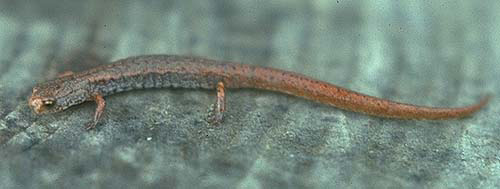The four-toed salamander is a member of the lungless salamander family. Adult salamanders in this family do not have lungs but take in oxygen through their skin. Four-toed salamanders are smooth-skinned and reddish brown with a light gray speckled belly. They get their name from having 4 toes on their back feet when all other Connecticut salamanders have 5. They have a constriction at the base of their tail. They can be 2 to 4 inches long.
The range of the four-toed salamander is not continuous, they are mostly east of the Mississippi River and exist from Novia Scotia to Wisconsin. They extend south to the gulf but are not found in Florida. Four-toed salamanders have no protected status in Connecticut.
Adult four-toed salamanders are terrestial and live under rocks and logs in deciduous forests near wet areas. They prefer acidic habitats and like spaghnum moss. Adults are active from late winter into late fall. They hibernate over the winter underground. They are nocturnal.
Eggs are laid in the early spring and placed near water but not in it. Females form a cavity in moss at water's edge and then flip upside down to lay about 40 idividual eggs. Eggs are guarded by the female until they hatch. The aquatic larvae reach the adult stage in a few months.
Adult four-toed salamanders eat small insects and invertebrates, as do their larvae.
Four-toed salamanders can drop their tail if grabbed by a predator. The detached tail will continue to move, hopefully distracting the predator. The salamander can regrow a new one.
